When choosing beef, understanding aging methods is key. Dry-aged and wet-aged beef differ in taste, texture, and price, and each suits different preferences and occasions.
- Dry-aged beef is aged in climate-controlled rooms for 28–55 days, creating bold, nutty flavors and a dense, tender texture. It’s pricier due to moisture loss (up to 30%) and is ideal for premium cuts like ribeye or porterhouse.
- Wet-aged beef is vacuum-sealed and refrigerated for 7–21 days, resulting in a milder, juicier texture. It retains all its weight, making it more affordable and perfect for leaner cuts like filet mignon or strip steak.
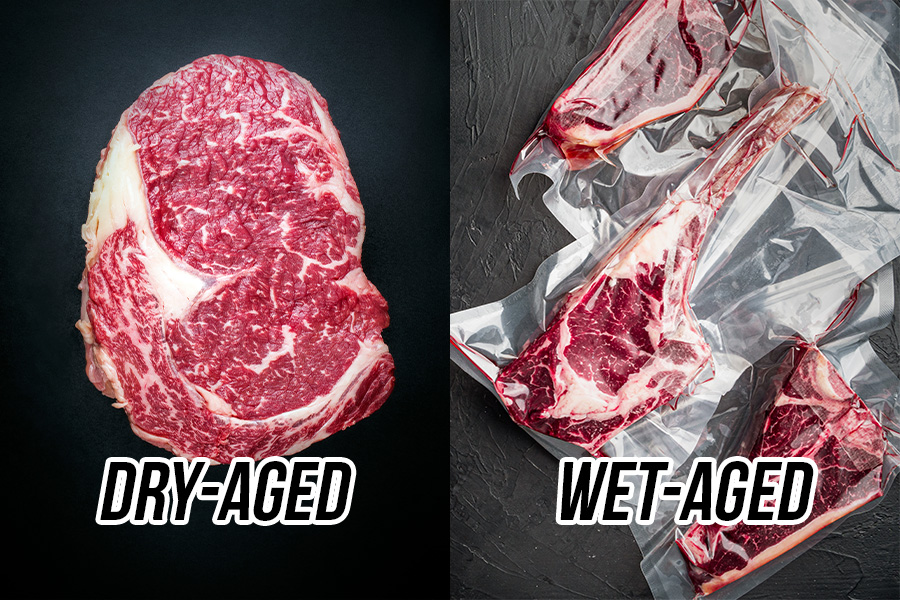
Quick Comparison:
| Feature | Dry-Aged Beef | Wet-Aged Beef |
|---|---|---|
| Flavor | Bold, nutty, earthy | Mild, sweeter |
| Texture | Dense, tender | Juicy, softer |
| Weight Loss | Up to 30% | None |
| Cost | Higher | More affordable |
| Best Cuts | Ribeye, porterhouse | Filet mignon, strip steak |
Dry-aged beef shines for special occasions with minimal seasoning, while wet-aged beef works well for everyday meals or recipes with marinades. Your choice depends on your flavor preference, budget, and cooking style.
Dry vs Wet Aged Steak What’s Better? Very Surprising Results!
What Is Dry-Aged Beef
Dry-aged beef is all about enhancing flavor and tenderness through a controlled aging process. This isn’t just about letting meat sit around – it’s a meticulous method that involves maintaining precise temperature, humidity, and airflow. It’s a craft perfected over decades, delivering the rich flavors and textures that steak lovers and upscale dining establishments rave about.
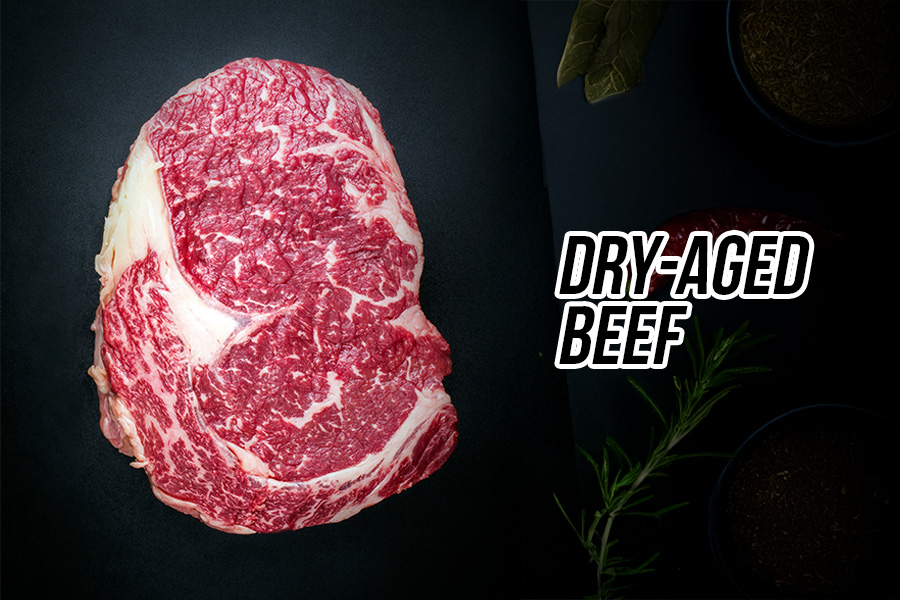
How Dry-Aging Works
The process starts with large cuts of beef being hung in specialized, climate-controlled rooms for 28 to 55 days. These rooms are carefully maintained at temperatures between 32°F and 39.2°F, with airflow set between 1.6 and 6.6 feet per second.
During this time, natural enzymes work on breaking down muscle fibers and connective tissues, making the meat more tender. At the same time, moisture slowly evaporates from the beef, concentrating its natural flavors. By the end of 30 days, the meat typically loses 15–35% of its weight due to moisture loss and trimming.
The controlled environment also allows beneficial bacteria to form a crust on the meat’s surface. While this crust is trimmed off before cooking, it plays a key role in developing the beef’s signature flavor. This careful transformation is what gives dry-aged beef its extraordinary taste and texture.
Taste and Texture of Dry-Aged Beef
Dry-aged beef is famous for its rich, layered flavors, often described as nutty, buttery, and deeply beefy. Some cuts even develop earthy, umami notes, with a taste that can resemble aged cheese. The texture is equally special: the breakdown of muscle fibers creates a tenderness that’s hard to match, while the moisture loss results in a firmer, denser bite. When cooked, the dry surface creates an incredible sear, adding a crisp, caramelized crust to the meat.
Common Cuts and Pricing
Ribeye, strip loin (New York strip), sirloin, tenderloin, T-bone, and porterhouse are the most popular cuts for dry-aging. These cuts are chosen for their high marbling and large size, which help them retain moisture during the aging process. Bone-in cuts like ribeye, T-bone, and porterhouse are especially prized because the bone adds flavor and provides extra protection during aging.
Ian Boden, owner of The Shack and Maude & the Bear, highlights the importance of bone-in cuts:
"I like bone-in. In my opinion, it’s pretty necessary as it helps with loss, right? Because it’s drying, you’re getting the same surface area and permeation, but you’re cutting off the bones anyway, so I feel like you have a little bit more stability, and you can age it for a little bit longer with a little less loss."
Dry-aged beef comes with a higher price tag, and for good reason. The process is time-intensive, and the meat loses up to 30% of its weight during aging. This means a larger initial cut results in a smaller, more concentrated final product, which drives up the cost per pound. To balance quality and cost, experts recommend starting with cuts that weigh at least four pounds, as smaller pieces are more prone to excessive weight loss.
What Is Wet-Aged Beef
Wet-aged beef offers a different method for aging meat compared to the traditional dry-aging process. Instead of hanging the meat in specialized rooms, wet-aging involves sealing the beef in vacuum-packed plastic bags and storing it in refrigeration. This approach became popular with the rise of vacuum-sealing technology, as it combines convenience and affordability while still delivering tender and flavorful meat.
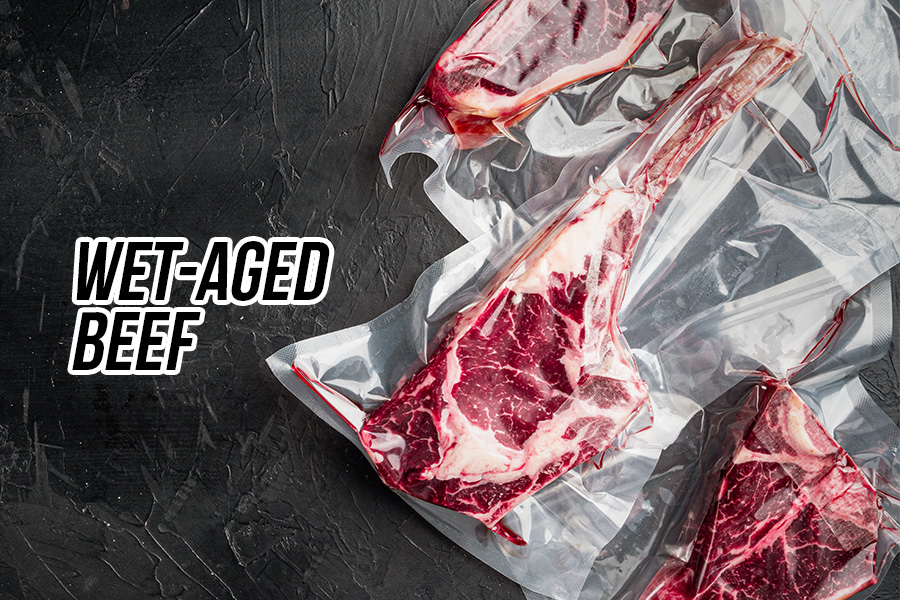
How Wet-Aging Works
With wet-aging, cuts of beef are vacuum-sealed and refrigerated for a period typically lasting 7 to 21 days. During this time, the meat rests in its natural juices, allowing enzymes to break down connective tissues. This process tenderizes the beef while preventing moisture loss, so the meat retains its original weight and juiciness.
As described by Rosebud Steakhouse:
"Wet aging involves vacuum-sealing cuts of meat in plastic and storing them in refrigeration for several days. This process helps to tenderize the meat by breaking down connective tissues and enhancing its natural flavor."
While wet-aging promotes tenderness, it doesn’t produce the concentrated flavors found in dry-aged beef. Instead, it creates a flavor and texture profile that stands apart.
Taste and Texture of Wet-Aged Beef
Wet-aged beef is known for its milder, fresher flavor and its juicy, tender texture. However, some people find it slightly watery compared to the firmer bite of dry-aged beef.
Aging the meat in its own juices can sometimes introduce a fresh, metallic taste. In certain cases, it may also develop gamey or sour notes with a bloody quality. These characteristics make its flavor profile distinct, though less intense than dry-aged options.
Common Cuts and Pricing
The wet-aging process is particularly suited to lean cuts of beef, such as flat iron, filet mignon, and boneless strip steak. Since this method minimizes weight loss, it reduces overall costs, making wet-aged beef a more affordable choice.
This affordability has made wet-aged beef a staple in most supermarkets. It’s a popular option for home cooks who want quality aged beef at a lower price compared to dry-aged varieties. By balancing cost and quality, wet-aged beef has become a go-to choice for many.
sbb-itb-5ae85c5
Main Differences Between Dry-Aged and Wet-Aged Beef
Understanding the differences between dry-aged and wet-aged beef can help you make smarter choices when selecting meat. While both methods create tender, flavorful beef, their processes lead to distinct variations in taste, texture, and cost.
Side-by-Side Comparison
Here’s a quick look at how dry-aged and wet-aged beef stack up against each other:
| Feature | Dry-Aged Beef | Wet-Aged Beef |
|---|---|---|
| Aging Process | Aged in open-air, climate-controlled conditions | Sealed in vacuum packaging with its own juices |
| Flavor Profile | Bold, nutty, earthy, and robust | Mild, fresh, and sometimes slightly sweet |
| Texture | Dense, concentrated, and very tender | Juicier with a softer, spongier feel |
| Weight Loss | Loses up to 50% of its original weight | Retains all its weight |
| Common Cuts | Ribeyes, T-bones, porterhouse steaks | Flat iron, filet mignon, strip steak |
| Typical Cost | 30–50% higher price | More budget-friendly |
| Best Cooking Methods | High-heat searing, minimal seasoning | Versatile; great for marinades and complex recipes |
Dry-aged beef is known for its bold, intense flavor with nutty and earthy undertones – often likened to the complexity of blue cheese. On the other hand, wet-aged beef offers a fresher, sweeter taste that pairs beautifully with a wide range of seasonings and sauces. These flavor differences make dry-aged beef perfect for simple preparations that let its natural taste shine, while wet-aged beef thrives in recipes with layered flavors.
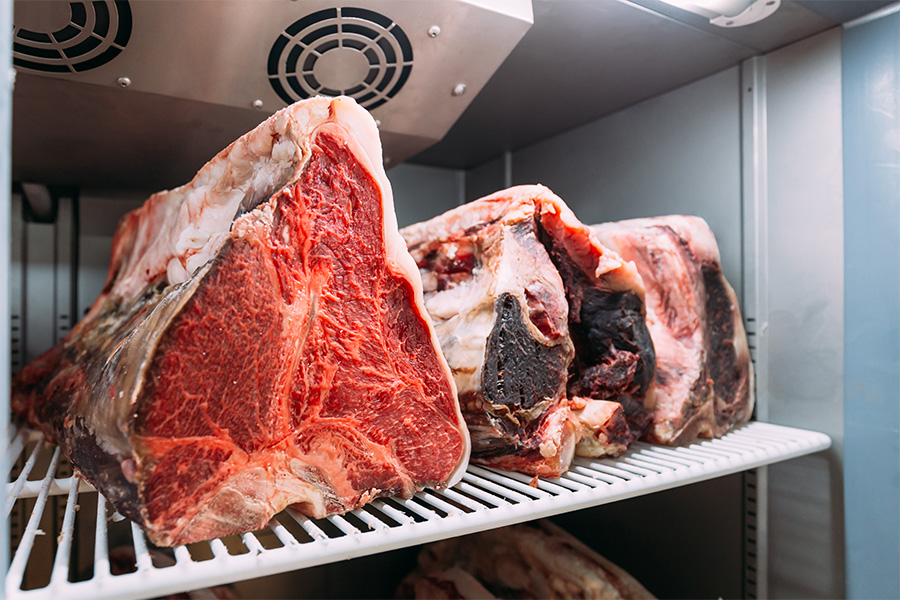
The price difference is another factor to consider. Dry-aged cuts, like ribeye, often cost $26–$28 per pound, reflecting the time and care involved in the process. Wet-aged beef, being quicker and less labor-intensive to produce, is generally more affordable.
The type of cut also plays a role in the aging method. Dry aging suits fattier cuts like ribeyes and porterhouse steaks, which can handle the moisture loss during the process. Wet aging, by contrast, is often used for leaner cuts such as flat iron or filet mignon.
How to Choose the Right Beef for Your Needs
When choosing beef, consider the flavor you’re after, your budget, and the occasion. These factors will help you select the best option.
Tips for Picking the Best Option
Your budget often dictates your choice. Wet-aged beef is a great pick for affordable, tender, and juicy steaks. It’s consistent in quality and works well for everyday meals or family dinners without stretching your wallet.
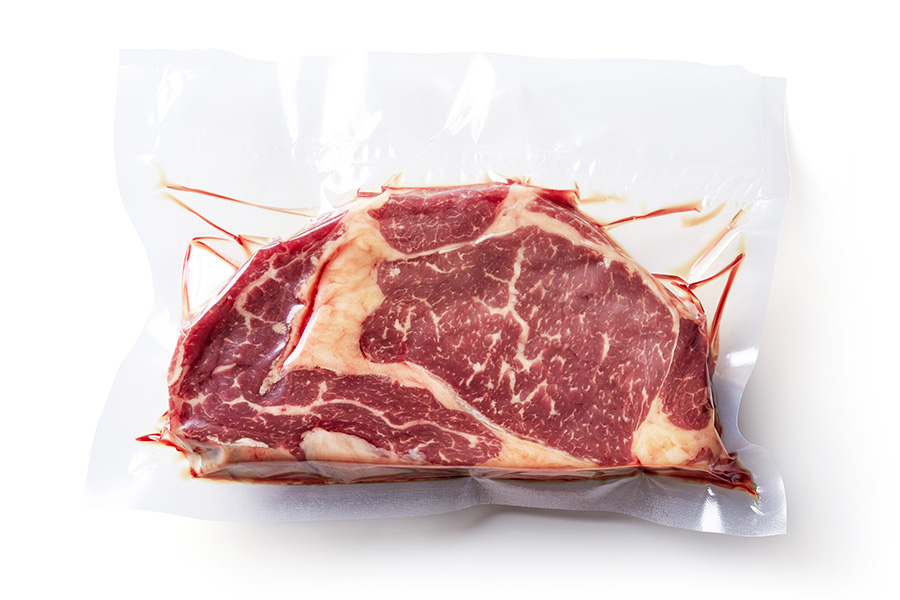
For those special moments – like anniversaries, dinner parties, or when you simply want to treat yourself – dry-aged beef is worth the splurge. Its rich, bold flavors bring a premium touch to any celebration and deliver a steakhouse-quality experience at home.
Flavor preference is another key factor. If you enjoy a clean and mild beef flavor that pairs well with marinades, sauces, or seasonings, wet-aged beef is a versatile choice. On the other hand, dry-aged beef stands out with its nutty, umami-packed profile. It’s best enjoyed with minimal seasoning – think salt, pepper, and a quick sear over high heat – to let its natural flavors shine.
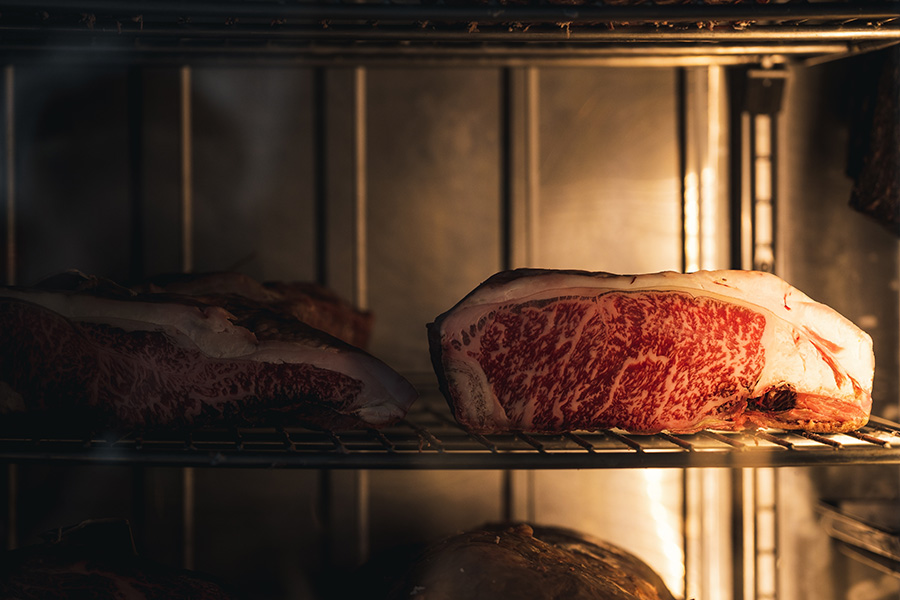
Your cooking method also matters. Wet-aged beef retains moisture, making it suitable for a variety of techniques, from grilling to slow cooking. Dry-aged beef, with its intense flavor and firmer texture, thrives with high-heat preparations that create a perfect crust while maintaining its complexity inside.
If you’re still unsure, seeking advice from experts can make the decision easier.
How Wild Country Meats Can Help
Wild Country Meats is here to guide you in finding the perfect beef for your needs. As a family-owned business since 1968, they know that every customer has unique tastes and requirements.
Their skilled butchers can help you pick the right cut and aging method, whether you’re planning a simple dinner or a grand celebration. They offer both wet-aged and dry-aged options, and their team is always ready to answer your questions, ensuring you leave with the ideal choice for your budget and cooking style.
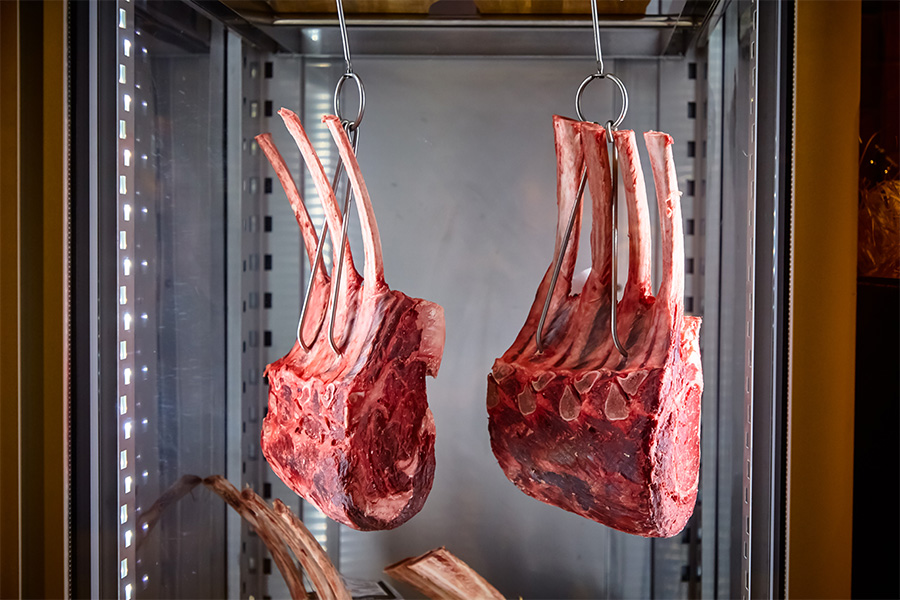
Wild Country Meats also provides custom processing services. If you’re processing your own cattle or need specific cuts prepared to your liking, their USDA-inspected facilities deliver full traceability and precise customization. You can even choose how long to age your beef for that perfect flavor.
Prefer shopping online? Their user-friendly system lets you browse and order with ease, whether for pickup or delivery. This allows you to take your time and make an informed choice.
With a reputation for quality and a "Made in Oklahoma" certification, Wild Country Meats ensures you’ll enjoy top-notch products no matter which aging method you choose. Their dedication to excellent service and personalized advice makes them a trusted partner for all your beef needs.
Conclusion
Both aging methods bring something special to the table, enhancing beef in their own unique ways. Dry-aging allows beef to rest in controlled open air, resulting in bold, earthy, and nutty flavors with a firmer texture and a moisture loss of 15–30%. On the other hand, wet-aging, where beef is vacuum-sealed, produces milder, sweeter, and rich beef flavors with consistent tenderness.
"Simply put, aging steak means letting meat rest under specific conditions to enhance tenderness and flavor… Just like a fine wine, aged meat develops a richness and complexity that a non-aged steak simply can’t match." – Sullivan’s Steakhouse
This quote perfectly captures how aging transforms beef, not just in taste but also in its overall value. Wet-aged beef, with its quicker process and lower cost, is ideal for everyday meals. Meanwhile, dry-aged beef, though more expensive and time-intensive, delivers a luxurious steakhouse experience that’s perfect for special occasions.
Your choice might come down to personal preference. Wet-aged beef works well for those who enjoy versatile cuts that pair beautifully with marinades, while dry-aged beef appeals to those seeking a more intense and straightforward flavor.
Beyond flavor, the cut of beef you choose plays a big role, and expert advice can make all the difference. For instance, Wild Country Meats, a family-owned business operating since 1968, offers USDA-inspected beef with a minimum 21-day aging process, ensuring quality that matches your taste, cooking style, and budget.
FAQs
What’s the best way to cook dry-aged and wet-aged beef to bring out their flavors?
Dry-aged beef truly stands out when prepared using high-heat techniques like searing or grilling. These methods develop a savory crust that pairs perfectly with its bold, concentrated flavors. For thicker cuts, try starting with a quick, high-heat sear to lock in juices, then finish cooking in the oven at a lower temperature to ensure it cooks evenly.
On the other hand, wet-aged beef offers more flexibility and shines with a variety of cooking methods. Whether you’re grilling, roasting, pan-searing, or slow cooking, its gentler flavor profile makes it a great canvas for a range of recipes and seasonings. This makes wet-aged beef an excellent option for everyday meals or trying out new culinary ideas.
How does aging affect the nutritional value of dry-aged and wet-aged beef?
The aging process affects the nutritional makeup of beef by decreasing its moisture content, which in turn concentrates nutrients such as protein and fat. Dry-aged beef, specifically, undergoes enzymatic changes that can improve its flavor, tenderness, and even its digestibility. On top of that, both aging techniques naturally lower the levels of certain bacteria, which can contribute to better food safety.
Although the nutritional differences between dry-aged and wet-aged beef are minimal, the distinct textures and flavors each method produces can greatly influence your dining experience. Ultimately, the best choice comes down to your personal taste preferences and how you plan to prepare the beef.
Can I safely age beef at home, and what steps should I follow to ensure the best results?
Aging beef at home is possible, but it demands strict attention to specific conditions to ensure it’s safe and delicious. The process hinges on maintaining a steady temperature between 34°F and 36°F, keeping humidity levels at 85-90%, and ensuring proper air circulation to avoid spoilage.
For the best outcome, focus on aging large cuts of beef, like whole subprimals, instead of smaller portions like individual steaks. It’s also crucial to work in a clean, sterilized environment to prevent the growth of harmful mold or bacteria. With the right setup and careful monitoring, you can create top-notch aged beef right in your own kitchen.

